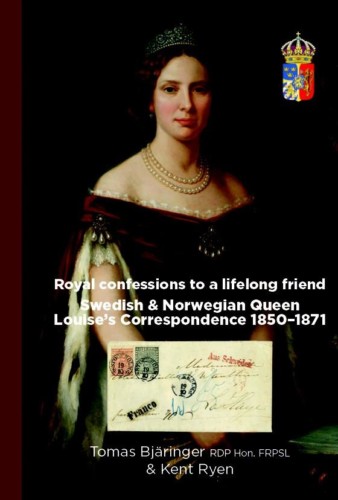
In English, perfectly bound (21.5 x 30.5 cms), 176 pages, colour throughout. SEK 700 (+ SEK 200 postage). Available from nordisk@filateli.se.
In today’s world postal history literature has seen some rather remarkable changes. In addition to the traditional treatment of rates and routes, the social and historical background is getting increasingly important when discussing items of postal history. Who sent the letter and to whom was it mailed and in which context? The answers to these questions frequently provide not only interesting reading but also adds to our enjoyment when studying these items. It is a rare occurrence for philatelists to be privy to the private correspondence of a reigning queen. However, this actually became reality when a hoard of old letters were handed in to Schwenn and Dr. Derichs, two German auction houses, in 1967. They had all been mailed from Sweden or Norway to a lady in The Netherlands. As it turned out, the sender of all these letters was Crown Princess (Queen from 1859) Lovisa (or Louise) to Miss Victoire Wauthier, her old governess in The Hague. From 1850 until 1871, they maintained their correspondence with an almost daily exchange of letters. It was Swedish stamp dealer Rolf Gummesson who acquired many of the covers and who discovered their true provenance.
This correspondence is the subject of a new book by Tomas Bjäringer RDP Hon. FRPSL and Kent Ryen. It is basically a work in two parts with the first one being an introduction to the two ladies and the contents of surviving letters. This part of the book was written by Ryen. Princess Louise (1828-1871) wrote most of her letters in French with a sprinkling of words in Dutch, German and Swedish. She tells about daily life in the Palace or she provides the latest court gossip often using nicknames for the persons involved. There is a most useful listing of the major names being mentioned in the correspondence referred to in the book. In 1850 Louise married Crown Prince Carl (1826-1872) who acceded to the throne of Sweden (and Norway) as King Carl XV in 1859. He was very much a philandering womaniser but somehow the couple managed to get along pretty well. Carl was a talented painter and the artist Fritz von Dardel (1817-1901) was a frequent visitor to the palace. The book includes numerous depictions of life in the royal family by Dardel. In fact, the volume is replete with excellent illustrations including a portrait of Queen Louise on the cover. In this painting she appears to be a most attractive lady but Mr. Ryen notes that she never was a stunning beauty. It rather seems that the fact that Louise was the prospective heiress of a major fortune might have been a significant factor when arranging the marriage in 1850.
The second part of the volume deals with the postal history and this section of the book has been contributed by Tomas Bjäringer, a prominent postal historian and researcher. The correspondence includes letters sent from Sweden or Norway to Miss Victoire Wauthier in The Netherlands from the pre-philatelic period until the introduction of the Skilling Banco issues in 1855 and the subsequent Vapen (Coat of Arms) issue first released in 1858. The book lists 16 Skilling Banco covers, 98 Coat of Arms covers and 100 pre-philatelic covers. Most of the stamped covers are illustrated in the book. This part of the book is basically a textbook of postal history research describing not only the various cancels but also the postal routes and the often quite complicated rates. This is done in a very comprehensive way. At the time Sweden and Norway were united and the Swedish crown prince served as Viceroy in Kristiania (today’s Oslo) for some time before succeeding his father in 1859. Thus Louise spent time in Norway as well. Numerous covers are depicted with comments explaining the routes and the rates. Many passed through the Swedish post office in Hamburg. Mr. Bjäringer also explains how each part of a letter’s journey was taxed. All this is an education in postal history at its very best. Not surprisingly, attempts have been made to improve the looks of many of the more valuable covers some of which were not in the best of shape when first offered. Fortunately many covers were pictured when first sold by auction in Germany in 1867. A comparison of these photographs with subsequent pictures makes it obvious that there have been many changes including the removal or additions of postal and other markings. Cancels have been improved on and there are cases where damaged stamps with pieces missing have been repaired. Several of these covers are depicted and described pointing out the relevant differences. It is not known who was responsible for doctoring the covers but, by comparing the illustrations in the different auction sales, it has been possible to determine when this restoration work was carried out. Today it is generally felt that old covers are best left in their original condition. In his comments in this chapter of the book, Tomas Bjäringer underlines the need to always have old and potentially valuable covers examined by experts which certainly is very good advice.

